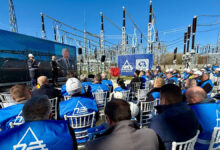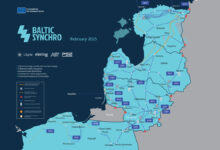Romania amid Rising Gas and Electricity Prices
Regional Challenges and Future Implications

In 2024, Romania ranked among the most expensive energy markets in the European Union (EU), occupying third place in the spot markets ranking. At the same time, accelerated consumption of gas from storage and price volatility point to significant challenges in the short to medium term. These developments reflect tensions in Europe’s energy sector, exacerbated by the halt in the transit of natural gas through Ukraine and rising demand in regional markets.
Romania, regional leader in electricity prices
With an average price of €103.5/MWh in 2024, Romania was second only to Ireland and Italy among the most expensive spot electricity markets in the EU. High prices are explained by several internal and external factors.
Market structure: The day-ahead market (DAM) operated by OPCOM, which trades more than a third of domestic consumption, is affected by volatile supply and demand.
Production capacities: Despite new renewable units coming on stream, Romania remains dependent on energy produced from conventional sources like coal and natural gas, which are more expensive.
Exports to the Republic of Moldova: At certain intervals, Romania has become a net exporter, helping to cover the Republic of Moldova’s energy needs, reflecting regional solidarity but putting pressure on domestic prices.
Regional implications
Romania is at risk of maintaining its top position in terms of high energy prices, which could affect the competitiveness of industry and the population’s purchasing power. At the same time, its role as a supplier to the Republic of Moldova underlines the importance of better integration of regional markets and strategic planning.
Gas crisis: A new test for Europe and Romania
Dependence on natural gas remains a vulnerability for Europe and Romania. The rapid emptying of underground gas storage facilities in the region has brought their level to just 70%, 25 percentage points below the maximum filling level.
Several main factors contributed to this situation. First of all, stopping transit through Ukraine, with the suspension of Russian gas flows putting additional pressure on available resources and accelerating their depletion. Then there was market volatility, so that the rise in prices on the Dutch TTF exchange, the benchmark for Europe, was also felt on the Romanian market, where gas was traded at the equivalent of €51/MWh at the end of the year. Weather forecasts also had an influence on the price, as a longer or colder than expected winter season could exacerbate the gas crisis and lead to further price increases.
In Romania, the amount of gas in storage has fallen to 63% in just one and a half months, with more than a third of the gas in storage being consumed, a steeper fall than the European average, according to Gas Infrastructure Europe. On January 8, 2025, the filling rate of storage facilities in Romania was 61.74%.
However, according to Energy Minister Sebastian Burduja, Romania has almost 2 billion normal cubic meters (Nm³) in storage, with a daily consumption of up to 40 million Nm³, covered by production during the cold season (20-25 million Nm³) and what is withdrawn from storage (the difference until consumption is covered, so maximum 20 million Nm³, although the maximum withdrawal capacity is up to 35 million Nm³).
“We have 2000 units stored, we are consuming 20 a day, so in two months we will consume 1200 million Nm³ and we will be left with 800 million Nm³. In March, a total consumption of 300 million Nm³ is expected. Then the injection cycle begins, and we start stocking up again for the following winter. So, we have about half a billion Nm³ more gas in storage than we need,” the official explained.
“Private Romanian suppliers have recently exported gas to the Republic of Moldova, approx. 5 million Nm³ in recent days. Private companies also import similar quantities of gas via Bulgaria, which does not affect our ability to cover our national consumption,” said Sebastian Burduja.
“What Romania has done well in recent years is the investment in the Iasi-Ungheni gas pipeline, which has a transmission capacity of over 6 million cubic meters, which fully covers the natural gas consumption between the Prut and the Dniester,” Sebastian Burduja also mentioned.
Medium-term implications
The medium-term implications of the gas crisis relate to high replenishment costs (replenishing stocks in 2025 could be more costly than in previous years due to price volatility and competition for available sources), economic volatility (rising energy and gas prices may have a knock-on effect on inflation, competitiveness and economic stability) and dependence on liquefied natural gas (LNG), as Romania and other European countries increasingly rely on LNG, which brings new logistical and financial challenges.
Transition towards a greener energy mix in Romania
Although Romania benefits from significant renewable resources, the transition to a greener energy mix remains incomplete. Dependence on natural gas and the difficulties of integrating renewable generation into the national grid remain challenges.
Looking ahead, investment in renewables is needed, with the development of wind and solar projects potentially reducing dependence on conventional sources and stabilizing prices in the long term. Also, energy efficiency programs for industry and households could reduce consumption and thus pressure on markets, and regional collaboration through better integration with energy markets in Central and Eastern Europe could bring economic and energy benefits.
Romania is at a critical point from an energy sector perspective. High electricity and natural gas prices, accelerated stock consumption and volatile European markets reflect both structural vulnerabilities and the effects of regional tensions.
To meet these challenges, Romania needs to adopt proactive policies focused on energy transition, diversification of energy sources and regional integration. This is the only way to reduce its economic vulnerability and strengthen its role on the European energy scene.






